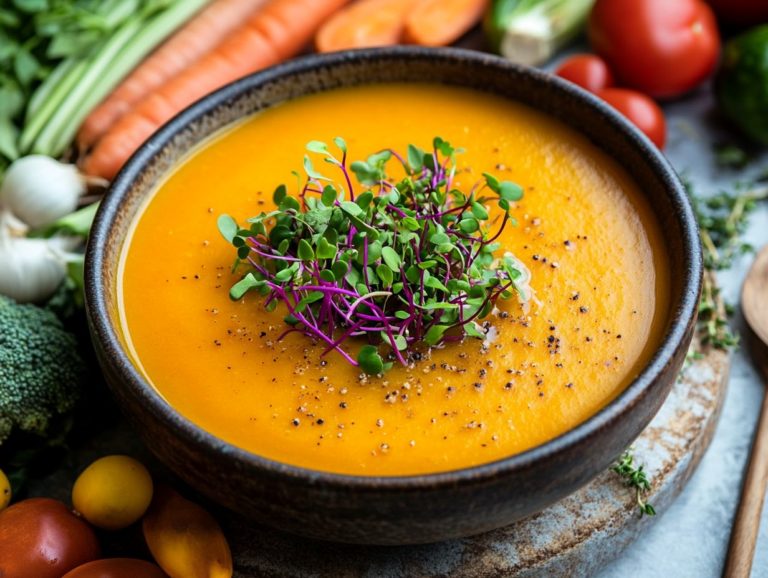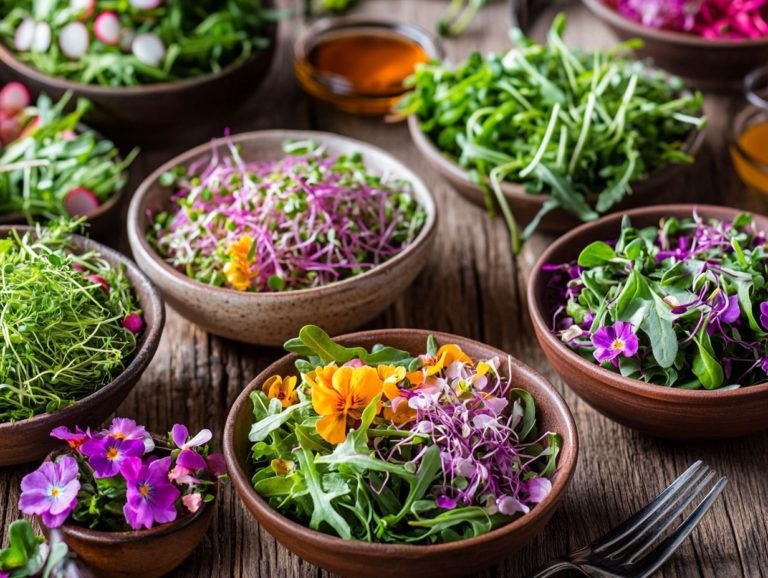27. The Best Microgreens for Stir-Fry Dishes
Microgreens are your secret weapon in the kitchen tiny, edible plants bursting with flavor and nutrients that make for a remarkable enhancement to your stir-fry dishes.
This exploration delves into their impressive nutritional benefits and how they can elevate the taste of your meals. You ll discover five top microgreens that are perfect for stir-frying, along with practical tips and enticing recipes for easy incorporation.
You will also find guidance on growing your own vibrant greens at home.
Essential safety precautions for handling these delightful and nutritious microgreens will also be addressed. Immerse yourself in the world of microgreens and see how they can truly transform your cooking experience!
Contents
Key Takeaways:
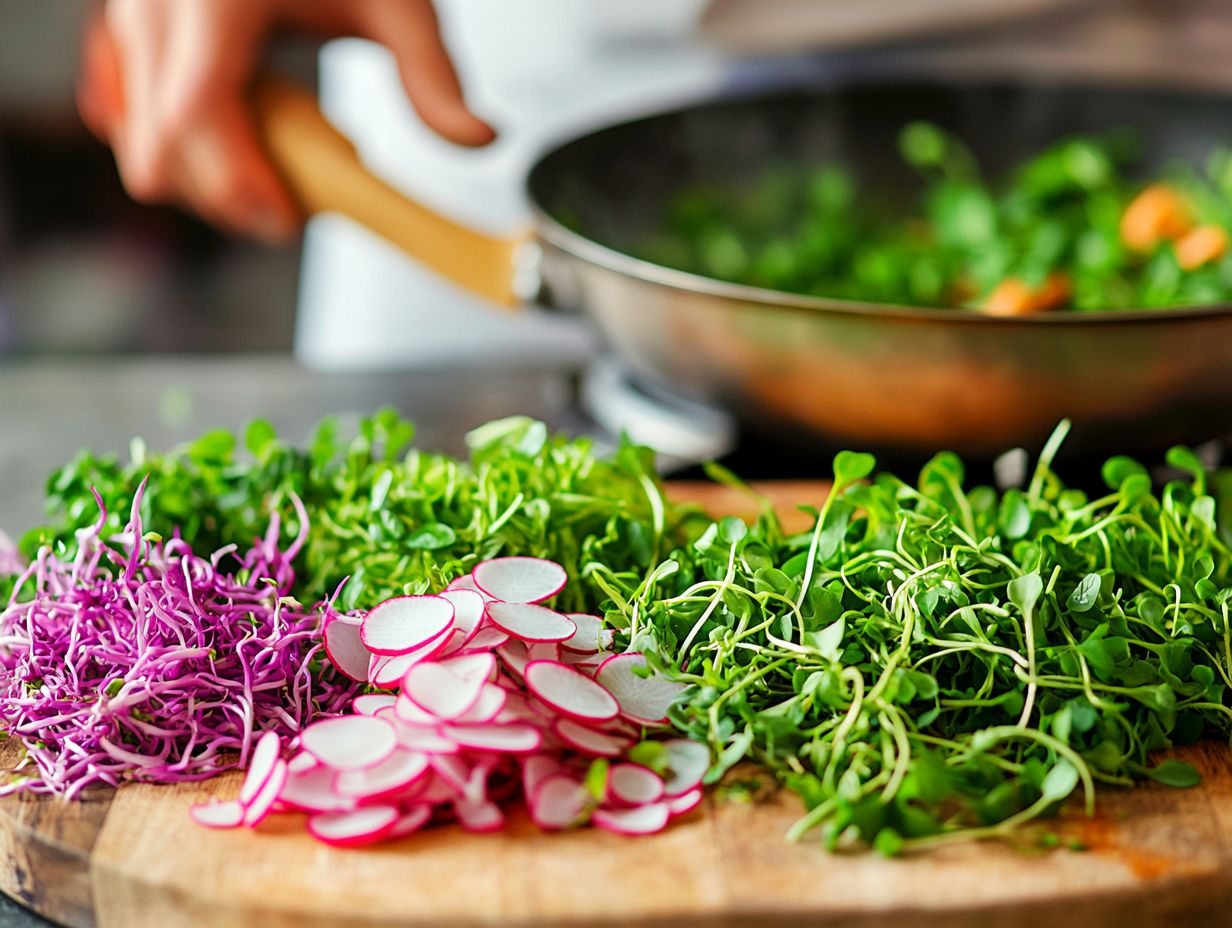
- Microgreens are young, nutrient-packed plants that can add flavor and nutrition to stir-fry dishes.
- The top 5 microgreens for stir-fry dishes are broccoli, kale, cilantro, radish, and mustard.
- Incorporate microgreens into stir-fry dishes by using them as a garnish, adding them to the stir-fry, or including them in a sauce or dressing.
What are Microgreens?
Microgreens are young, edible plants that you typically harvest just after the first true leaves have sprouted. They offer a burst of flavor and vibrant color that can truly elevate any dish.
These little greens aren’t just visually stunning; they’re also packed with nutrients, making them a favored choice among both chefs and home cooks.
Their versatility allows you to enhance salads, sandwiches, and even savory delights like avocado toast and warm vegetables. Chefs everywhere are excited to use microgreens in their dishes, recognizing their potential to transform healthy meals and vegan recipes into extraordinary experiences.
With a variety of types including arugula, basil, and radish microgreens come in an array of flavors, ranging from peppery to sweet, each adding a unique twist to your culinary creations.
Their impressive nutrient density means they offer significant health benefits, providing you with increased vitamins and antioxidants while delivering a fresh, vibrant taste, making them perfect for flavorful side dishes.
Chefs often sprinkle these greens atop hearty plant-based bowls or incorporate them into fresh salsas and dressings, enhancing both the presentation and nutritional value of their dishes.
Whether mixed into salads, including vibrant beet salad, or used as a garnish for grilled meats, the allure of microgreens in modern cooking continues to flourish, inviting you to explore a rejuvenating approach to nourishing meals.
Benefits of Using Microgreens in Stir-Fry Dishes
Incorporating microgreens into your stir-fry dishes not only introduces a delightful crunch but also elevates the meal s health benefits.
These tiny greens are packed with vitamins and minerals, providing a significant health boost to your creations, especially when added to rice dishes or plant-based meals.
Their unique and savory flavors can enhance the taste of your favorite recipes, making them an excellent addition to any dish featuring warm cooked vegetables, tempeh, or rice.
Whether you re whipping up a simple veggie stir-fry or crafting a complex dish with layered flavors, fresh microgreens can truly transform your cooking experience and elevate your healthy meals.
Nutritional Benefits and Flavor Enhancement
Microgreens are nutritional powerhouses. They often contain more vitamins and antioxidants than grown greens!
They also add a delightful flavor to dishes like salads and spicy avocado tacos. This complexity enhances your meal without overpowering it.
Take arugula microgreens, for example. Their vibrant color and peppery notes are rich in vitamins C and K. They provide a zesty kick to grain bowls and vegan wraps, making your culinary experience exciting. You can also explore must-try microgreen varieties for salads like radish microgreens, which have a satisfying crunch and a touch of spice, perfectly complementing fish dishes and making your soups pop.
By adding these nutrient-dense greens to your meals, you elevate the flavor while boosting the overall nutritional content. They’re ideal for creating vibrant, healthful meals that truly stand out!
Types of Microgreens for Stir-Fry
In stir-fry, the selection of microgreens can elevate your dishes significantly. Consider robust varieties like broccoli and arugula for a bold flavor explosion. Pair them with the sweet, delicate notes of pea shoots that harmonize beautifully with richer ingredients like BBQ tempeh or falafel.
With the right mix of microgreens, you can craft a vibrant and nutritious dish. It serves as both an exquisite side and a satisfying main course, enriching your overall culinary journey.
Top 5 Microgreens for Stir-Fry Dishes
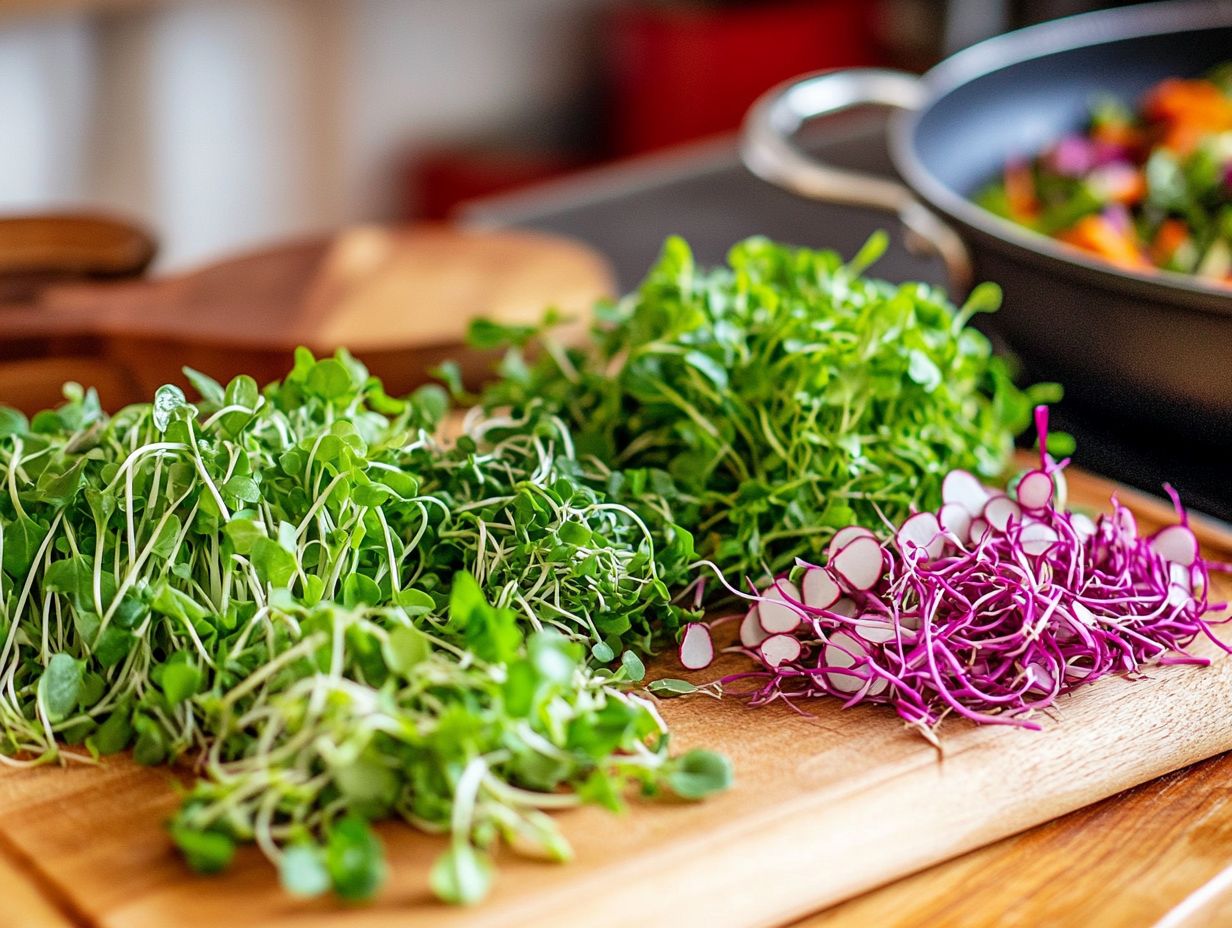
Selecting the right microgreens can truly elevate the flavor and nutrition of your stir-fry dishes. They make a vibrant addition to pizza or hummus while delivering essential vitamins, minerals, and antioxidants for your health.
A variety of microgreens can transform simple stir-fries into culinary masterpieces. For example, the robust flavor of broccoli microgreens pairs beautifully with stir-fried chicken and vegetables. The spicy kick of radish microgreens complements shrimp or tofu stir-fries perfectly. Beet microgreens add subtle sweetness, ideal for a colorful veggie stir-fry. Meanwhile, pea shoot microgreens lend tender sweetness that balances savory flavors. To explore more, check out the best microgreens for nutritional value.
The nutty taste of sunflower microgreens elevates dishes like tacos, gourmet pizzas, and even burgers, adding both crunch and nutrition!
How to Incorporate Microgreens into Stir-Fry Dishes
Adding microgreens to your stir-fry creates a delightful way to enhance both flavor and nutrition. Pair them with savory combinations for the best results.
Start by selecting microgreens that harmonize with your ingredients. For instance, try spicy radish microgreens with BBQ tempeh or mix pea shoot microgreens with fresh vegetables for a lighter dish, perfect for salads!
To keep their vibrant color and nutritional benefits, add microgreens towards the end of the cooking process. Whether it s avocado toast or a delicious salad, the possibilities are truly endless!
Tips and Recipes for Using Microgreens
Using microgreens creatively can unlock a realm of flavor and nutrition in your culinary endeavors. A fantastic tip is to mix different types of microgreens to craft layered flavors in your dishes. For example, pairing spicy radish microgreens with sweet sunflower microgreens offers a delightful taste experience.
You might consider adding microgreens to cold dishes like salads or dressings. This includes pesto and hummus, enhancing both presentation and health benefits. Explore a variety of microgreen recipes, from simple smoothies to intricate layered salads, and you ll discover a world of endless possibilities.
Beyond salads, microgreens are incredibly versatile and can elevate everything from appetizers to main courses. Imagine incorporating them into hummus for a vibrant dip loaded with nutrients, or using them in falafel or omelette for a fresh crunch that beautifully complements the rich flavors of chickpeas and spices.
Sushi enthusiasts can even roll microgreens into their creations, adding a delightful zing to each bite. Whether you re garnishing a main dish or blending them into a creamy dressing, these tiny greens not only look stunning but also serve as an excellent way to boost the nutritional content of your meals.
Growing Your Own Microgreens for Stir-Fry
Growing your own microgreens for stir-fry is rewarding. It’s a sustainable practice that brings fresh, nutritious greens right to your kitchen, perfect for enhancing your vegan recipes.
Whether you have a sprawling garden or just a small windowsill, microgreens can thrive in various containers, making them accessible for everyone.
By cultivating these vibrant greens, you secure a steady supply that elevates your meals. You can enjoy both savings and an unparalleled flavor boost in salads, wraps, and even as delightful toppings for flatbread or pasta.
Step-by-Step Guide to Growing Microgreens
To successfully grow your own microgreens, start by choosing the right seeds based on the flavors you want to elevate in your cooking think spicy radish, sweet pea shoots, or even beet microgreens for a unique taste.
Prepare a shallow container filled with quality soil, ensuring it has good drainage to support healthy growth. Sow the seeds evenly, cover them lightly with soil, and water gently to keep the soil consistently moist.
Position the container in a sunny spot or beneath grow lights. Soon enough, you ll witness your microgreens sprouting in just a few days, ready to infuse your dishes with fresh, vibrant flavors, including delightful sushi rolls.
This fun project adds a burst of color and texture to your meals while offering a nutritional boost. Microgreens are brimming with vitamins and minerals. When your microgreens reach a few inches in height, typically around 7 to 14 days after planting, you can harvest them by cutting just above the soil line.
Incorporate these tiny greens into salads, sandwiches, or as garnishes for soups and main dishes. They enhance both taste and presentation. Don’t shy away from experimenting with different seed varieties; this will allow you to add a personal touch with unique microgreens to elevate your dishes you create.
Safety and Precautions when Using Microgreens

Incorporating microgreens into your culinary creations elevates your dishes, but prioritizing safety and proper handling is essential for a truly healthy eating experience. While microgreens are packed with nutrients, they can harbor harmful germs that can cause illness if not managed correctly, making thorough washing a must before consumption.
Store your microgreens in a cool, dry place and aim to consume them fresh to preserve their vibrant flavor and nutritional benefits. By adhering to these straightforward safety measures, you can dive into the benefits of microgreens today and transform your meals!
Proper Handling and Storage
Proper handling and storage of microgreens is essential for preserving their freshness, flavor, and nutritional value. After harvesting or purchasing them, gently rinse your microgreens under cool water to remove any dirt or contaminants. Dry them thoroughly using a salad spinner or a clean kitchen towel.
Store your microgreens in a breathable container that allows air to circulate, lined with a paper towel to absorb excess moisture. Keep them in the refrigerator to maintain optimal freshness for days. This ensures they re ready to elevate your next healthy meal.
By managing moisture levels carefully, you can significantly extend the lifespan of these vibrant greens. Microgreens, especially the best microgreen varieties for beginners, not only add a burst of color to your dishes but also enhance flavors, making every bite more delightful. When stored properly, they can remain crisp and potent for up to a week, allowing for versatile use in salads, sandwiches, and garnishes.
Keep an eye on your microgreens! If you see any wilting or spoilage, remove them right away to help maintain the quality of the remaining batch.
Remember, the secret to experiencing the full flavor profile of these tender shoots lies in their freshness.
Final Thoughts and Recommendations
The versatility and nutritional benefits of microgreens are essential for elevating your culinary creations. Whether you re incorporating them into stir-fries, salads, or wraps, these tiny greens can enhance flavors and provide a wholesome boost to your meals.
Their vibrant colors and varied textures not only enhance the visual appeal of your dishes but also deliver a potent punch of vitamins, minerals, and antioxidants. By adding microgreens to breakfast omelets, grain bowls, or using them as garnishes for soups, you can amplify their health benefits even further.
If you’re keen to maximize your nutritional intake, consider integrating them into snacks think topping avocado toast or blending them into smoothies. With a plethora of varieties available, including radish, beet, and basil microgreens, the creative culinary possibilities are endless.
Harness the power of these miniature greens to nourish your body and tantalize your taste buds in every meal. Start experimenting with microgreens today and elevate your meals!
Frequently Asked Questions
What are microgreens and why are they a great addition to stir-fry dishes?
Microgreens are young edible plants that are harvested after just a few weeks of growth. They are packed with nutrients and flavor, making them the perfect ingredient for stir-fry dishes.
Which microgreens work best in stir-fry dishes?
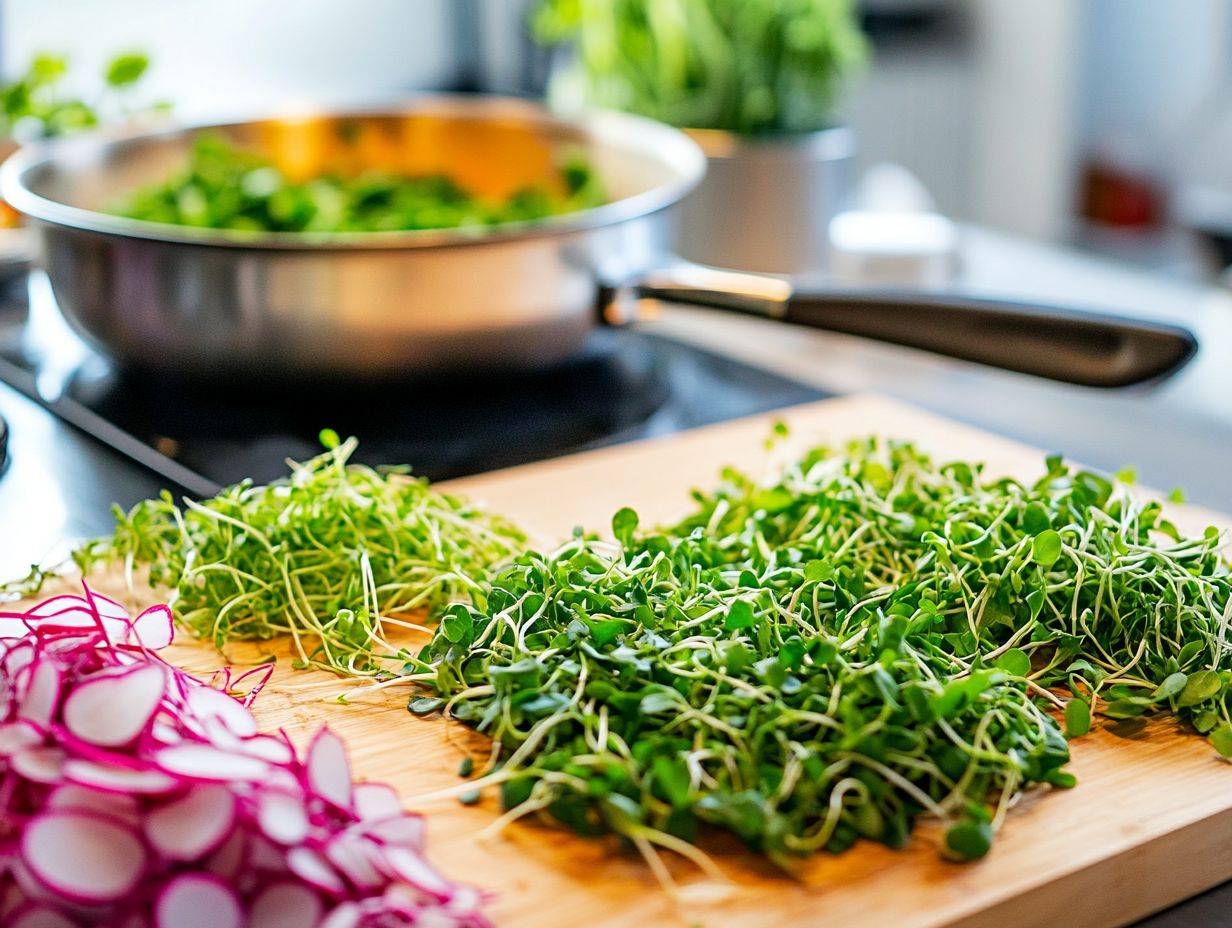
Some of the best microgreens for stir-fry dishes include broccoli, kale, mustard, and radish. These greens have a slightly bitter and spicy taste that pairs well with the bold flavors of stir-fries.
Do all types of microgreens have the same nutritional value?
No, different types of microgreens have varying levels of nutrients. However, all microgreens are rich in vitamins, minerals, and antioxidants, making them a healthy addition to any stir-fry dish.
Can I use microgreens as a substitute for other greens in stir-fry dishes?
Yes, microgreens can be a great substitute for other greens in stir-fry dishes. They have a more concentrated flavor and a delicate texture, making them a delicious addition to any stir-fry recipe.
How should I prepare and cook microgreens for stir-fry dishes?
Microgreens should be washed and dried before using them in stir-fry dishes. They can be added to the stir-fry towards the end of cooking, as they only need a minute or two to wilt and release their flavors.
Are there any other ways to incorporate microgreens into stir-fry dishes?
Aside from using them as a topping or ingredient in a stir-fry, you can also blend microgreens into sauces or marinades for an added boost of nutrition and flavor. You can also use them as a garnish for a pop of color and freshness on top of your stir-fry dishes.


